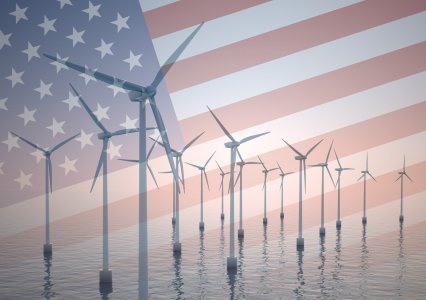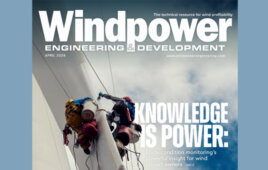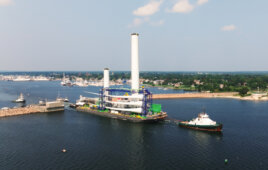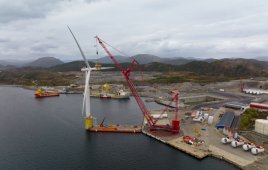By Georgena Terry, research associate, Clean Energy States Alliance
 In late March, President Joe Biden announced an offshore wind goal of 30 GW by 2030 in a manner that protects environmental assets and creates employment. Through a coordinated multi-agency approach, Biden plans to fast track the deployment of utility scale offshore wind. The focus will be on the creation of well-paying jobs, infrastructure investment, and R&D activities.
In late March, President Joe Biden announced an offshore wind goal of 30 GW by 2030 in a manner that protects environmental assets and creates employment. Through a coordinated multi-agency approach, Biden plans to fast track the deployment of utility scale offshore wind. The focus will be on the creation of well-paying jobs, infrastructure investment, and R&D activities.
To date, the Biden Administration has taken a variety of actions to accelerate offshore wind development. Federal agencies have identified new wind energy areas, facilitated environmental review for projects, and supported additional research. Activities abound on the east, west, and gulf coasts. Below is a summary of recent federal action on offshore wind.
East Coast
- In March, the Bureau of Ocean Energy Management (BOEM) announced that after nearly three years of review and consideration it was designating new Wind Energy Areas (WEA) in the New York Bight. The development of this WEA has the potential to support up to 25,000 jobs and to generate over 7 GW of wind power. In mid-June, BOEM announced an offshore wind lease sale for this area. Comments on the proposed sale notice are due by August 13, 2021. The auction will take place 30 days following the publication of the Final Sale Notice in the Federal Register.
- BOEM announced a Notice of Intent (NOI) to prepare an Environmental Impact Statement (EIS) for Ocean Wind. This 98-turbine facility off the New Jersey coast would produce 1,100 MW, enough power for 500,000 homes.
- BOEM announced the final approval for Vineyard Wind, an 84-turbine 800 MW facility offshore Massachusetts. This will be the United States’ first large-scale commercial offshore wind project.
- BOEM will review Ørsted and Eversource Energy’s Construction and Operations Plan for the Revolution Wind project in preparation for the project’s Environmental Impact Statement (EIS). The final EIS is expected to be issued by March 2023. The 100-turbine, 704 MW project is 20 miles off the Rhode Island coast. BOEM is also reviewing the South Fork Wind Farm, a 15-turbine, 132 MW project southeast off the Long Island coast. It expects to complete the review by January 2022.
West Coast
- BOEM, the Department of Defense, and the State of California identified the “Morro Bay 399 Area” off California’s central coast as a potential WEA. The 399 square mile area has the potential to support 3 GW of offshore wind power.
- BOEM also identified an unspecified area in the Humboldt Bay call area, 25 nautical miles offshore of the North Coast of California. BOEM is studying examining wind array scales, cable landfall, interconnection locations, and transmission routes to determine compatibility with the Department of Defense’s training and testing operations. A full buildout of the area could support 1.6 GW of offshore wind capacity.
Gulf of Mexico
- BOEM has published a Request for Interest to investigate possible wind development opportunities offshore Louisiana, Texas, Mississippi, and Alabama. The Gulf of Mexico has several desirable assets with respect to offshore wind, including shallow water and smaller waves. Hurricanes and low winds could be addressed through technology innovations. A 2020 NREL study of the area determined that offshore wind has a technically feasible potential of 508 GW.
In addition to these regional steps the Biden administration has taken to support offshore wind, it is also supporting domestic supply chain buildout and national research and development efforts. Recently, the National Offshore Wind Research and Development Consortium announced a project to develop a national supply chain roadmap and to analyze its supply chain database to identify gaps and opportunities. Understanding the logistics of the supply chain is key to ensuring that the United States has enough construction and manufacturing capability to support the planned offshore wind projects.
These federal actions early in the Biden administration will help states advance their renewable energy goals while building domestic manufacturing and workforce capabilities. Nationally, it is estimated that $12 billion per year will be invested in offshore wind projects, creating employment opportunities for over 44,000 workers in the offshore wind industry as well as an additional 33,000 ancillary jobs by 2030.
Filed Under: Featured, Offshore wind





Offshore wind can make a big difference. The Intergovernmental Panel on Climate Change (IPCC) defined “lifecycle greenhouse gas emissions” as the total amount of greenhouse gas output that could be expected over the full life of a system for generating electricity, from obtaining materials, on through the construction process, the operation of the system in generating electricity, to end-of-life waste management. IPCC researchers estimated that the life-time greenhouse gas emissions of offshore wind would be less than two percent of those from burning coal to generate electricity, and less than three percent of those from burning natural gas.
Great. At last we have a president who cares about our enviornment. We are slowly destroying our earth by lack of understanding, and in many cases lack of concern about the world we are leaving for future generations. we need a good federal program to encouage the installaion of renewable energy such as solar panels, wind mills, and above all a sense of conservation of our resources.